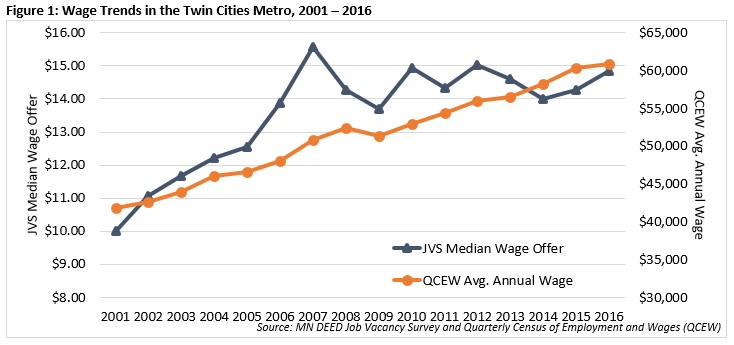 The Minneapolis-St. Paul metropolitan area is a national leader in finance, advanced manufacturing, agriculture and retailing.
The Minneapolis-St. Paul metropolitan area is a national leader in finance, advanced manufacturing, agriculture and retailing.
Medical devices, electronics and processed foods are strong suits recognized globally.
Want the freshest data delivered by email? Subscribe to our regional newsletters.
6/7/2017 12:23:55 PM
Tim O'Neill
The Twin Cities Metro Area has passed a number of key labor market milestones recently. One, the region has now added over 200,000 jobs since the low of the recession. Two, with these gains, the region has surpassed 1.7 million total covered jobs for the first time. Three, total job vacancies have reached their highest levels since 2001. Along with job gains and increasing vacancies, the region’s unemployment rate has dropped to 3.2 percent, while the labor force participation rate has gradually declined.
What does all of this mean? To put it simply, a tight labor market.
With tight labor market conditions, employers are finding it increasingly difficult to fill open positions. As mentioned, there are a record number of vacancies in the Twin Cities – 57,739 vacancies as of the most recent job vacancy survey. As of April 2017, there were only 53,700 unemployed persons. The Twin Cities has a ratio of less than one (0.9) unemployed persons to every one job vacancy.
With such a small number of unemployed persons to draw from, compounded by baby boom retirements, employers will have to become increasingly creative to fill open positions. Some creative methods include “reverse job fairs,” increased on-the-job training, new partnerships with K-12 and post-secondary education institutions and reaching out to non-traditional sources of labor market supply.
Raising wages is another time-tested method for finding workers. As Figure 1 shows, wages have been increasing in the Twin Cities Metro. According to wage data from DEED’s Quarterly Census of Employment and Wages (QCEW) tool, average annual wages within the metro have increased by an average of 3.0 percent since 2001. While wages dipped during the Great Recession in 2009, they have continued to climb through 2016 as the labor market has tightened.
Analyzing median wage offers from the Job Vacancy Survey shows a similar trend. Wage offers climbed significantly during the expansion of the 2000s, faltered during the Great Recession, and trended upward in recent years. Specifically, average annual wage offers climbed by 3.0 percent between 2014 and 2016. Wage offers since 2014 have increased the most in Real Estate, Rental, and Leasing; Arts, Entertainment, and Recreation; Accommodation and Food Services; Finance and Insurance; Retail Trade; Information; Construction; and Professional, Scientific, and Technical Services (Figure 1).

Contact Tim O’Neill at timothy.oneill@state.mn.us or 651-259-7401.